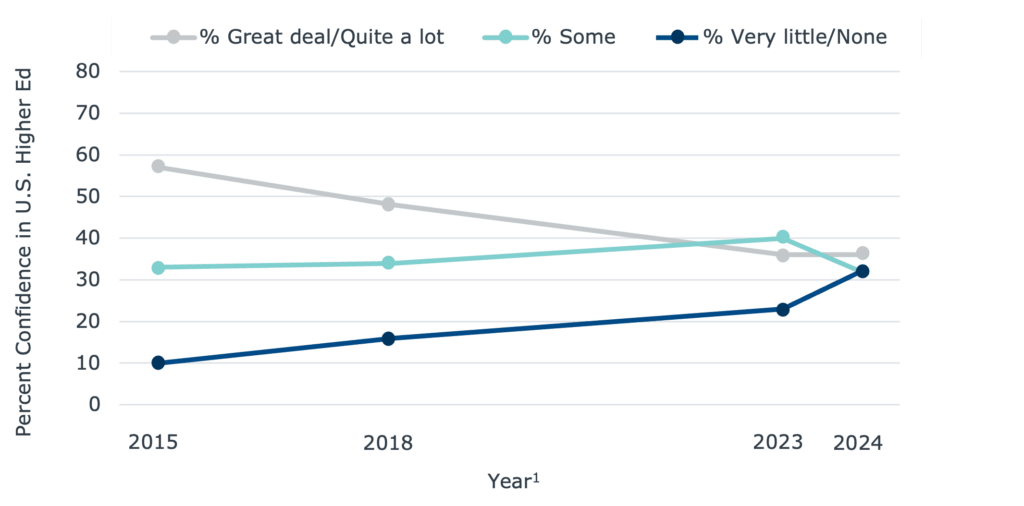IgnitED 2024 sneak peek: 3 major pressures that higher ed leaders are facing this fall
Every year, EAB convenes presidents, provosts, chief business officers, and heads of strategy for our annual IgnitED summit. Across the two days, we share our latest research and analyses of industry trends, facilitate in-depth peer conversations, and help create action plans to bring new ideas back to campus. This fall, we will focus on strategies for navigating three of the biggest challenges facing the higher education sector:
- Election year polarization and growing skepticism about relevance
- Weakening business model foundations
- AI-driven disruption to work and learning
Read on for a sneak peek of these challenges, which we’ll examine further at IgnitED.
1. Election year polarization and growing skepticism about relevance
Amid today’s hostile policy environment and ongoing culture wars, external stakeholders have increasingly called higher ed’s value into question. While EAB analysis has found that most sensationalist headlines do not reflect the actual value or perception of higher ed, the repetition of negative narratives still poses risks to enrollment and funding, especially in this tense election year.
Beyond recent headlines, long-standing public perception trends are also cause for real concern. Over the last decade, public confidence in colleges and universities has dropped significantly. In 2015, 57% of the public had a great deal or quite a lot of confidence in higher ed while 10% had little or none. In 2024, only 36% of Americans have a great deal or quite a lot of confidence and 32% have little or no confidence in higher ed.
Declining confidence in U.S. higher education over the last decade
Poll question: Please tell me how much confidence you, yourself, have in higher education: a great deal, quite a lot, some, or very little?

1) Gallup survey data is only available for 2015, 2018, 2023, and 2024.
To truly counteract concerns about higher ed’s relevance, campus leaders must embrace an outside-in strategy that is “anchored” around the needs and priorities of external stakeholders―starting with increasingly value-conscious prospective students and their parents, and expanding to the interests of employers, legislators, community members, and donors. Ultimately, colleges and universities that intentionally drive, measure, and articulate their local and regional impact in a compelling way will be best positioned to attract future enrollments, dollars, and public support.
More at IgnitED
During IgnitED, we’ll share strategies and case studies that span areas like K-12 partnerships and pipeline development, workforce-aligned curriculum, community-engaged research and service, and mutually beneficial economic development. We’ll also highlight best practices for developing and communicating an impact narrative that goes beyond just dollars and inputs.
2. Weakening business model foundations
Undergraduate enrollments have continued to stabilize over the last year as the industry recovers from pandemic-induced losses, but these positive trends are not enough to completely counter the longer-term decline since 2019. The demographic cliff is already here, and unfortunately this dip is part of an even bigger phenomenon of demographic decline, with the youth population expected to fall even more dramatically starting in 2041.
-
What is the demographic cliff?
The demographic cliff refers to the 6.3% decline in the 15-to-19-year-old population from 2021 to 2032.
While that might seem far off, colleges and universities are facing no shortage of near-term enrollment and revenue challenges. College-going rates have continued to fall, exacerbating broader demographic declines. Changes in the athletics environment have threatened to shake up student-athlete enrollment and retention, with risks especially high at mid-majors and Division II member institutions as student-athletes may leave for schools with more name, image, and likeness (NIL) opportunities.
Tuition discounting has now reached an all-time high at private nonprofit colleges and universities. The average discount rate for first-time, full-time, first-year students at private institutions in 2023-2024 was 56.1%, which represents a 9.8% increase over the last decade. Net tuition revenue increased slightly over the last year at private institutions, but growth was less than 1% and hasn’t kept up with inflation. At the same time, external disruptions―like the botched FAFSA rollout and recent OPM financial challenges and regulations—have added to market uncertainty and exacerbated revenue concerns.
Unfortunately, these downward pressures on revenue have coincided with persistent cost growth. While inflation has eased slightly since peaking in 2022 at 5.2%, colleges’ expenses still rose 4% in 2023, which is well above historic norms. As a result, structural deficits have become increasingly common, with 37% of senior leaders indicating in a recent EAB survey that their institution is currently facing one. That has, in turn, fueled a wave of campus cuts and layoffs, as well as institutional closures.
Squeezed from all sides, even colleges and universities in more favorable financial positions are proactively seeking ways to become lean, financially resilient institutions. To survive and thrive, campus leaders need to embrace new organizational models that enable greater efficiency. They also must grow their institution’s capacity for managing the ongoing changes necessary to weather today’s challenging climate and build a more sustainable long-term business model.
More at IgnitED
Our IgnitED discussion on this topic will focus on real-world cases of colleges and universities that have successfully implemented transformation initiatives, with a focus on people, process, and technology components as well as transferrable leadership lessons.
3. AI-driven disruption to work and learning
Within two months of launching, ChatGPT had 100 million active users. That unprecedented speed of adoption has ushered in a new era of AI for everyone, including higher ed. Almost 90% of students have admitted to using ChatGPT in their coursework. And looking forward, projections suggest that AI will augment the majority of roles across functional areas. Moreover, 75% of companies plan to adopt AI or AI-adapted technologies between 2023 and 2027.
But despite all the interest among students and employers, many colleges and universities are lagging behind in both readiness and adoption among faculty and staff. While 59% of students consider themselves “regular users” of AI, only 40% of professors say the same. And many faculty have indicated they lack confidence in their ability to utilize AI for teaching, with less than half feeling that AI will have a positive impact on teaching in the next five years. A recent EAB survey of student success professionals found regular generative AI use was a bit higher at 52%, but almost a third of respondents indicated they do not use or have never used AI in their roles.
Given this gap, campus leaders need to critically assess not only how they can better support and prepare their students for the future of work, but also how they can bolster internal training and business use cases. While there are potential risks and challenges associated with AI adoption, institutions that seize opportunities to leverage AI to enhance student outcomes as well as administrative efficiency will have a competitive advantage in the long run.
More at IgnitED
At IgnitED, attendees will have the opportunity to choose between two different breakouts. The first will dig deeper into student-facing and curricular AI innovations, like incorporating AI as a required competency in general education or helping prepare faculty to teach with AI. The second will share real-world examples of institutions that have harnessed the power of AI to streamline campus processes and reimagine on-campus roles.
Are you ready to respond to these pressures?
Join your peers for our two-day IgnitED summit. Our 2024-2025 series will feature new research from EAB about your most pressing issues, including public perception, student enrollment and readiness, financial sustainability, and AI. You’ll also have opportunities to network with peers and colleagues, as well as begin planning for campus adoption and implementation.

More Blogs

Is your yield rate okay?

The real demographic crisis isn't national—it's regional
